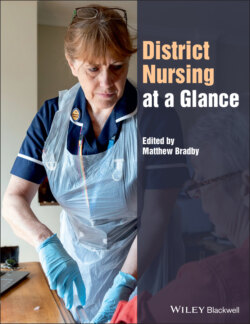Читать книгу District Nursing at a Glance - Matthew Bradby - Страница 10
Оглавление
Preface
The nurses who have written the chapters of this book are Queen’s Nurses. The title of Queen’s Nurse was reintroduced by the Queen’s Nursing Institute in 2007 as a way of recognising the excellence of community nursing practice in England, Wales and Northern Ireland, the three countries where the charity operates. The title has also subsequently been reintroduced north of the border by the Queen’s Nursing Institute Scotland. Today there are over 1700 Queen’s Nurses in every community specialism, not just district nursing.
This book is divided into six main parts, preceded by an introductory section.
Part 1 Introduction aims to give the reader an introduction to the heritage of the district nursing profession and also to the charity, the Queen’s Nursing Institute, which has been indelibly associated with the profession for over 130 years.
Part 2 The learning environment gives the reader an introduction to the framework of district nurse education at the present time, although this framework continues to evolve and develop at a rapid pace.
Part 3 Working in the community focuses on the district nursing team, on the systems and ethics that guide its successful working, and on the place of the individual within that team.
Part 4 Caring for the whole person in the community looks at the people district nurses will meet in their professional life as they carry out visits in their local community. It looks at the whole person, as a member of a family, of a culture and a community. That person may have carers, who may be friends or family members, or support workers. We have tried to use the word ‘person’ rather than ‘patient’; for people living with one or more long‐term conditions; they may not view themselves as a patient when they are being cared for at home, but they are all people whose quality of life is made significantly better by the support of a district nurse. Often it is this support that enables the person to live at home and avoid admission to hospital or residential care; in this role the nurse is both a vital support to the individual and their family and also a hugely important part of the whole health and social care system.
Part 5 Physical and mental health in the community looks at a whole range of physical and mental health conditions that are commonly encountered by district nurses during the course of their work. The conditions covered in the book are not meant to be exhaustive but are indicative of the kind of long‐term conditions that require an in‐depth knowledge of the person and careful case management of their condition. The skilled district nurse will have the ability, working in partnership with the person she cares for, to progress and improve their health. He or she will also be one of the most important sources of emotional and psychological support to the person and their family.
Part 6 Specialisms in the community explores some of the other specialisms that district nurses will encounter during their work. Again, this is not meant to be an exhaustive list but an introduction to some of the other specialisms that are employed by healthcare providers and voluntary organisations. This links back to Part 3 and the importance of collaborative working, drawing on the skills of the most suitably qualified professionals to deliver enhanced care to people in need.
Additional sources of information
Some of the chapters contain links to additional sources of information and a final chapter gives a list of References and further reading.
